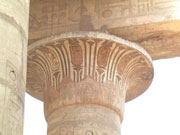ANCIENT TUNISIA:
ARCHAEOLOGY AND HSTORY
ARCHAEOLOGY AND HSTORY
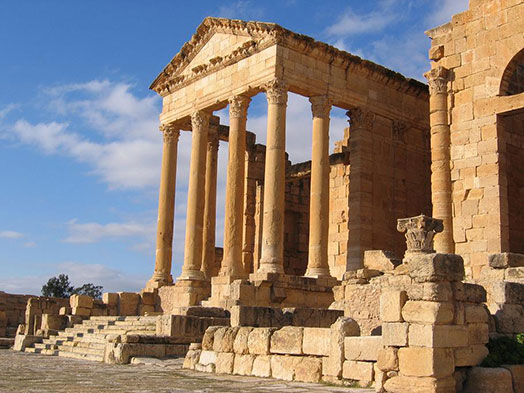
Roman temple of Minerva at Sufetula
"Against the Tiber's mouth, but far away,
An ancient town was seated on the sea;
A Tyrian colony; the people made
Stout for the war, and studious of their trade:
Carthage the name; beloved by Juno more
Than her own Argos, or the Samian shore.
Here stood her chariot; here, if Heaven were kind,
The seat of awful empire she designed.
Yet she had heard an ancient rumour fly,
(Long cited by the people of the sky,)
That times to come should see the Trojan race
Her Carthage ruin, and her towers deface;
Nor thus confined, the yoke of sovereign sway
Should on the necks of all the nations lay.
She pondered this, and feared it was in fate;
Nor could forget the war she waged of late
For conquering Greece against the Trojan state'.
Virgil, the Aeneid, Bk 1
An ancient town was seated on the sea;
A Tyrian colony; the people made
Stout for the war, and studious of their trade:
Carthage the name; beloved by Juno more
Than her own Argos, or the Samian shore.
Here stood her chariot; here, if Heaven were kind,
The seat of awful empire she designed.
Yet she had heard an ancient rumour fly,
(Long cited by the people of the sky,)
That times to come should see the Trojan race
Her Carthage ruin, and her towers deface;
Nor thus confined, the yoke of sovereign sway
Should on the necks of all the nations lay.
She pondered this, and feared it was in fate;
Nor could forget the war she waged of late
For conquering Greece against the Trojan state'.
Virgil, the Aeneid, Bk 1
THE TOUR
This three week study tour has an emphasis on the Roman and medieval Islamic monuments of Tunisia and the wonderful desert landscapes of the Sahara. We fly to Rome on Singapore Airlines and connect with our flight to Tunis. In Tunis we take a walk through the Ville Nouvelle (the French quarter) and spend a day walking in the ancient walled medina of the city. Here we explore the bustling markets, see the courtyard of the Grand Mosque and visit the medieval royal tombs.
The following day we visit the extensive ruins of Carthage where are located in the northern suburbs of Tunis. We see the old Punic harbour, the tophet cemetery (burial place of sacrificed children) and the excellent on-site museum. We also see the colourful in-situ Roman house mosaics and explore the Rome amphitheatre. In the afternoon we go for a walk through the beautiful village of Sidi Bou Said, famous for its blue and white houses and view over the Gulf of Tunis.
Our program then takes us on a day trip to visit Cape Bon, the nearby peninsula. Here we explore the fascinating ruins of the ancient Punic city of Kerkouane, famous for their houses with early mosaics and baths, and see the artefacts from the site In the afternoon we explore the impressive Punic quarries at Haouira where stone was quarried for the walls of Carthage.
The following day we head inland to explore the stunning Roman ruins of Dougga. An ancient Punic settlement it was greatly developed during the Roman era. We explore its awe inspiring and well preserved Temple of Jupiter, the Roman forum, the bath complex and magnificent Roman theatre. In the afternoon there is a short drive to the Ottoman fortress city of El Kef which will be our base for a few days. From here we take a day trip to explore the ancient settlement of Bulla Regia. This preserves stunning Roman house mosaics. We also see the quarries at Chemtou, famous in antiquity for its bright yellow stone which was much favoured by the Romans.
From El Kef we drive southwards, stopping to see the ruins of the frontier Roman town of Haidra. A legionary base in the Augustan period, it subsequently acquired an enormous Byzantine fortress. The ruins at Haidra are extensive and include an impressive Roman arch. We then continue onwards to the town of Sbeitla, which will be our base for two nights. The following morning we explore the fabulous temples of ancient Sufetula including the remarkably well-preserved Temple of Minerva in the Roman Forum. Other buildings at the site include the baths and a Roman bridge over the local river. There is free time in the afternoon for a swim in the hotel pool.
The following day we head south into the desert regions of Tunisia where we explore a number of oasis towns. These include Tamerza, perched in a dramatic desert valley, and Mides which hangs to the side of a steep gorge. In the afternoon we see the palm gardens and spring of Chebika. We then continue on to Tozeur which will be our base for 2 nights.
In Tozeur we explore the old quarter, famous for its decorative brick work, and explore the vast palm gardens of the oasis. We take 4-wheel drives south into the dunes of the Great Sand Sea and visit the sets used for the Star Wars movies. The following morning we head across the vast dry salt pans of the Chott el Jerid until we arrive at Douz. Here we head out into the open desert of the Sahara and have the opportunity for a camel ride.
We next continue to Matmata which is famous for its underground troglodyte houses that are carved from the sandstone. We have lunch at the famous Star Wars set of Luke Skywalker�s house. The next day we continue southwards to Tatouine where we explore some of the old ksars, medieval storage facilities. We visit the ancient village of Chenini and see its ruined fortress dating from the 12th Century. We also see Ksar Hadada, a series of fortified medieval granaries which were used in the Star Wars Movies.
Our program then takes us along the Mediterranean coast to the ancient medieval city of Sfax. The old medina is surrounded by impressive walls from the 9th century Aghlabid Period and hides a labyrinth of covered suqs which we explore. The following day we explore El Jem, the ancient Roman town of Thysdrus. Here we visit the stunning Roman amphitheatre, one of the best preserved in the world, and visit the local museum which houses some of the best Roman mosaics to be seen anywhere. We continue to Sousse which will be our base for two nights.
In Sousse we explore the ancient medina, which is famous for its remarkably well preserved 9th century Aghlabid fortifications. Inside the town we explore the Great Mosque, the rabat (small fortress) and Kasbah. We visit a local merchant�s house and see the Roman mosaics in the Sousse archaeological museum.
We then head inland, stopping at Kairouan, an important medieval Arab town. We explore the enormous Great Mosque dating back to the 8th Century and walk through the old quarter of the city. We then head north to visit the beautiful Roman ruins of Thuburbo Maius. These include a well preserved forum, Roman temples and baths. At the ancient site of Uthina we see the Roman amphitheatre and houses.
Our last day of the program is spent at the Bardo Museum in Tunis which contains one of the most stunning collections of Roman mosaics anywhere in the world. These have been removed from many sites around Tunisia and include a wide range of mythological subjects. There is time for last minute shopping in the medina of Tunis before we fly home to Australia.

Roman mosaic from El Jem
ITINERARY*
Day 1: Depart AustraliaOur flight on Singapore Airlines leaves Australia with a short stop over (normally 1-2 hours) in Singapore. We arrive in Rome and transfer to our Alitalia flight to Tunis.
Day 2: Arrive Rome - onward flight to Tunis - walk around the Ville Nouvelle
In the morning we arrive in Tunis, modern capital of Tunisia. We check into our hotel, freshen up and go for a leisurely walk along the boulevards of the new city of Tunis (the so-called Ville Nouvelle). This part of Tunis was built by the French in the late 19th Century and is full of excellent cafes. The area is dominated by the impressive Cathedral of St Vincent de Paul. Overnight Tunis.
Day 3: Tunis Medina (Old City) - afternoon at leisur
This morning we take a walk in the Medina (the old medieval walled city) of Tunis with its busy shopping suqs. We see the 9th Century Zitouna Mosque (also known as the Great Mosque), a wonderful mediaeval building reflecting the rich Islamic traditions of Tunis. We also see the lavishly decorated 18th Century Tombs of the Beys, enjoy a coffee in the old suq (covered markets), and visit a three-storey merchant's house. There is free time in the afternoon to walk in the bazaar where the shopping opportunities are endless! Overnight Tunis.
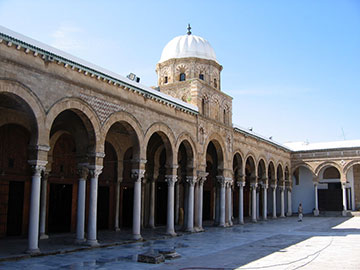 |
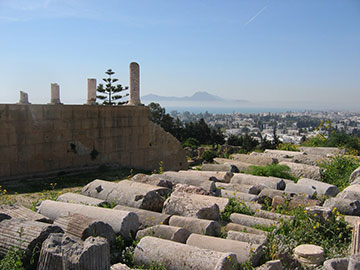 |
Tunis Great Mosque |
Carthage - ruins on the Bursa Hill |
Day 4: Carthage - Sidi Bou Said
The morning is spent exploring the ruins of the ancient Punic and Roman city of Carthage located a short drive north of Tunis. Once the capital of a mighty Empire, the ruins are spread over wide area. We visit the Bursa Hill acropolis and houses, explore the Carthage Museum, see the impressive Roman amphitheatre, the old Punic port area and the Tophet Cemetery. In the afternoon we visit the photogenic suburb of Sidi Bou Said with its spectacular views of the Bay of Tunis. This area is well known for its blue painted doors and coffee shops. Overnight Tunis.
Day 5: Kerkouane - Haouaria quarries
In the morning we visit the sea-side ruins of Kerkouane which are located on Cape Bon, a peninsula east of Tunis. Kerkouane is the best preserved ancient Punic city in the world and is justly famous for the 6th-4th Century BC Punic houses with some of the earliest mosaic floors in the Mediterranean. We also tour the local archaeological museum at Kerkouane. After lunch we head north to see the ancient Punic quarries near Haouaria. Overnight Tunis.
Day 6: Dougga
In the morning we travel west through the green Medjerja River Valley to the Roman site of Dougga (ancient Thugga). Here an entire Roman city is laid out before us with spectacular views over the valley. Highlights include the stunning 2nd Century AD Capitol (Temple of Jupiter), the magnificent Roman theatre dating to the time of Marcus Aurelius, the bath complex and numerous houses with mosaic floors. In the afternoon we travel the short distance to El Kef where we check into our hotel. Overnight El Kef.
.jpg) |
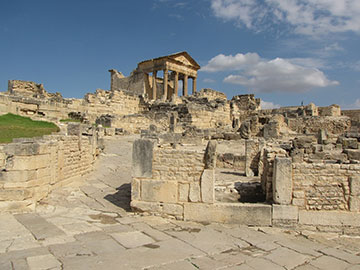 |
The Punic settlement of Kerkouane |
The Capitolium of Dougga |
Day 7: Bulla Regia - Chemtou
On this day trip from El Kef we visit the ruins of the beautiful Carthaginian and Roman site of Bulla Regia. A flourishing settlement during the 2nd Century AD, the site boasts an impressive forum with Capitolium (Temple of Jupiter), a theatre, an extensive bath complex, and stunning house mosaics, many perfectly preserved because the houses were partly subterranean. In the afternoon we visit the ancient Roman quarries at Chemtou, famous for their yellow stone which was exported throughout the Roman world for building and mosaics. We also see the ruins of a Roman theatre, temple and bridge. Overnight El Kef.
Day 8: Haidra - Kasserine
We head south of El Kef to Haidra, site of the beautiful Roman city of Ammaedara established as a base by the Emperor Augustus for the Third Legion. The site is spread along the banks of the Oued Haidra and is dominated by the very well preserved Byzantine fortress dating to AD 550. The ruins include Roman temples, a theatre and a triumphal arch built to commemorate the Emperor Septimius Severus in AD 195. We have a picnic lunch at the site overlooking the River. In the afternoon we travel south to Kasserine where we see an impressive Roman tomb before continuing to Sbeitla where we check into our hotel. Overnight Sbeitla.
Day 9: Sufetula
Today we explore the ruins of the fascinating ancient Roman city of Sufetula which are spread over a wide area. The city was founded as a Roman colony by the Emperor Vespasian in AD 70. One of the best preserved buildings is the magnificent Temple of Minerva in the Roman forum which still retains its original architrave. Other highlights include the Roman baths, the impressive Arch of Diocletian, an intact Roman bridge and numerous house mosaics. In the afternoon there is free time to rest, swim in the hotel pool, or go shopping in the small local bazaar. Overnight Sbeitla.
Day 10: Oasis route: Mides - Temerza - Chebika
In the morning we head south into the desert regions of Tunisia. We take a scenic drive through a series of mountain oases with old Berber villages. We see the ruins of the ancient town of Tamerza, located in a picturesque valley surrounded by palms. We also stop at the village of Mides, perched on the edge of a dramatic desert gorge. In the afternoon we explore the oasis of Chebika and visit the spring. There is a short drive to our hotel in Tozeur. Overnight Tozeur.
Day 11: Tozeur
We explore the old quarter of the oasis town of Tozeur which was built in the 14th Century - this is famous for its traditional brickwork. We then go for a walk in the enormous palm gardens (inhabited since Neolithic times) which are spread over 10 sq km and said to be watered by 200 springs. In the afternoon we take 4-wheel drives into the open desert. Fans of the Star Wars movies will enjoy exploring the movie sets at Nefta. Overnight Tozeur.
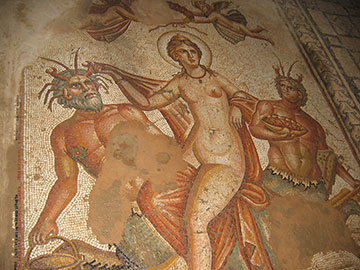 |
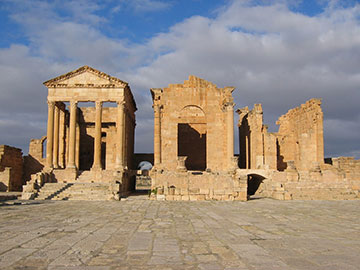 |
House mosaic from Bulla Regia |
The Temple of Minerva at Sufetula |
Day 12: Douz
In the morning we leave the oasis of Tozeur and cross the Chott el-Jerid, an immense salt pan covering more than 5000 sq km. We head to the desert town of Douz and check into our hotel. In the afternoon we explore the open dunes of the Sahara and take a camel ride. Overnight Douz.
Day 13: Matmata
We head east through stark desert landscapes to Matmata, famous for its troglodyte houses carved into the sandstone desert cliffs. We visit one of these houses and see a glimpse of traditional life. We also see the Star Wars set used as Luke Skywalker�s house in the original Star Wars movie New Hope. Overnight Matmata.
Day 14: Tatouine - Chenini - Ksar Hadada desert and Star Wars sets
In the morning we head south through the Jeffara Plains to Tataouine which is famous for its fortified residences and granaries (ksars). We visit the village of Chenini and see its ruined fortress dating from the 12th Century. We then head to Ksar Hadada, a series of fortified granaries, which were used in the Star Wars Movie Phantom Menace. Overnight Matmata.
Day 15: Sfax
In the morning we head north to Sfax, the second largest city in Tunisia. Inhabited since Phoenician times it is best known for its impressive 9th Century medina walls which were built by the Aghlabid Dynasty. In the afternoon we take a walk through the medieval medina with its covered souqs and explore part of the impressive ramparts and gates. Overnight Sfax.
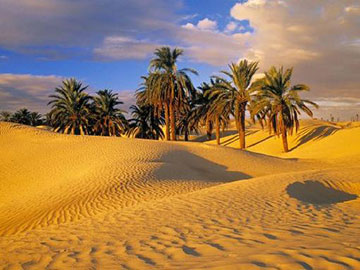 |
 |
The stunning desert landscape of Tunisia |
The theatre of El jem |
Day 16: El Jem - Museum and Roman Amphitheatre
Today we travel north by bus to El Jem, the ancient city of Thysdrus. In the morning we see the superb Museum of El Jem which houses one of the world's best collections of Roman mosaics. A highlight is the reconstructed 'House of Africa' which enables us to walk through an ancient Roman Villa. In the afternoon we tour the awe inspiring 3rd Century AD amphitheatre which still retains its underground cells for animals and gladiators. We continue on our way to Sousse. Overnight Sousse.
Day 17: Sousse medina - Museum
The day is dedicated to exploring the wonderful medieval medina (walled city) of Sousse. The city was originally founded by Phoenician traders in the 6th Century BC and was important in Roman times. Under the Islamic Aghlabid Dynasty (9th Century AD) the town was fortified and these walls are very well preserved today. We visit the Great Mosque and the ribat (fort) with its impressive watch tower. We also see the Late Ottoman house of a rich merchant family. In the afternoon we visit the Sousse Museum located within the fortified Kasbah; it houses a wonderful collection of Roman mosaics from the area and numerous Phoenician artefacts. Overnight Sousse.
Day 18: Kairouan
In the morning we head to the mediaeval city of Kairouan, an ancient walled city which was founded shortly after the Arab invasion in the late 7th Century AD. We visit the impressive Great Mosque, constructed in the early days of the settlement and incorporating numerous columns from dismantled classical buildings. In the afternoon we have lunch and take a walk in the Kairouan Medina. Overnight Kairouan.
Day 19: Thuburbo Maius - Uthina
We head north through vast olive groves to the ancient Roman city of Thuburbo Maius. Originally a Carthaginian city, it developed in the 2nd Century AD due to the trade in olive oil. It acquiring an impressive agora with Capitol (Temple of Jupiter) built in AD 168. Other fine buildings include two bath complexess, temples to Mercury and Baal and many houses with mosaics. In the afternoon we visit the ruins of Uthina, an impressive Roman site with a well preserved amphitheatre originally capable of sitting 10,000 spectators. A short drive then takes us to Tunis where we check into our hotel. Overnight Tunis.
 |
.jpg) |
The walls of Sousse medina |
Odysseus mosaic in the Bardo Museum |
Day 20: The Bardo Museum
The day is devoted to the magnificent Bardo Museum in Tunis, world-famous for its collection of Roman mosaics. These remarkable masterpieces, derived from a number of Tunisian sites, show many aspects of ancient life and religion. The collection is housed in a beautiful Ottoman Palace together with sculpture and art objects that are representative of Tunisian history. There is free time for last minute shopping in the medina of Tunis. We fly to Rome in the late afternoon. Overnight Rome.
Day 21: Fly to Australia
In the morning we head to Rome airport for our Singapore Airlines flight to Australia.
Day 22: Arrive in Australia
Arrive back in Australia.
* Please note that the Company reserves the right to make alterations to the itinerary in the period up to 60 days prior to a tour departure. The itinerary may also be subject to minor re-arrangement due to the scheduling of the operators and availability of access. If this occurs, the Company will endeavour to provide a comparable alternative.
